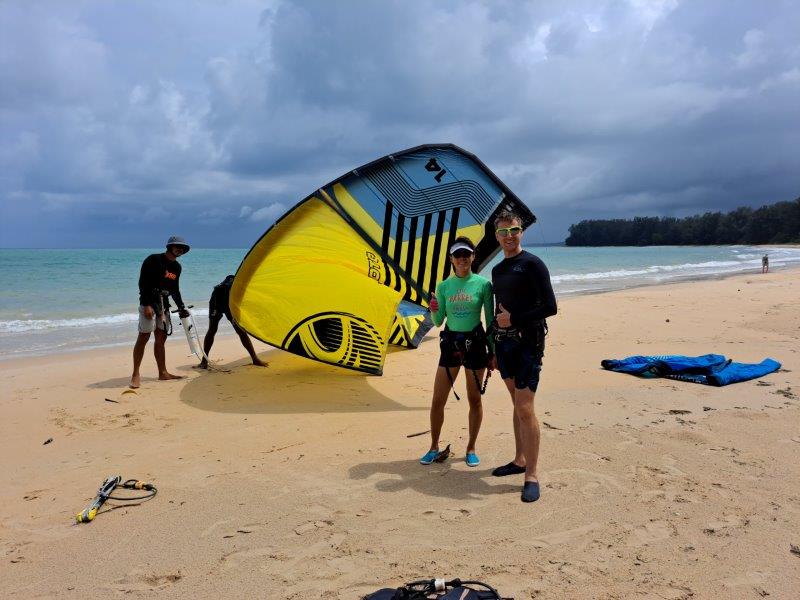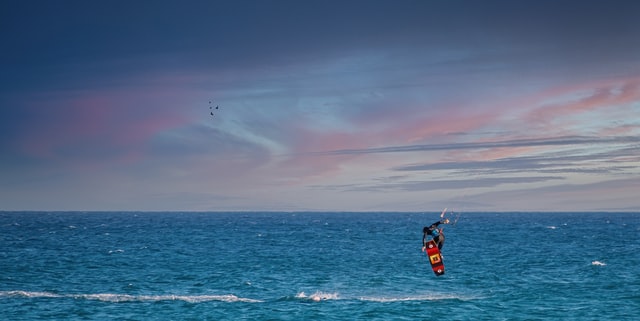Kitesurfing is a growing in popularity extreme water sport. It’s super fun and possible to pick up. You can continuously practice and learn the technicalities of the sport. And for those who might be wondering, it’s not only limited to strong stuntmen. People of all ages, gender, and body build can take part.

You’ll need to be comfortable with water and be at a decent fitness level. This is because pulling on the kite works out your core muscles. Swimming or being able to stay afloat is necessary. Wearing a life jacket is strongly encouraged but not mandatory in some countries. The last thing you want is to risk drowning if you fall off your kiteboard.
You might be thinking to yourself, “This seems like a fun hobby, but where do I begin?” So, if you’re wondering how you can join in on the fun—I’m here to assure you that there’s a way! With a bit of focus and dedication, you too could become a kitesurfer.
The learning stage for a beginner can be a bit dicey, unpredictable, and downright frustrating. It’s pretty much like learning anything new. But, in no time, you’ll get the hang of it, and the real fun will begin!
What is Kitesurfing
Kitesurfing is a wind-powered surface sport that requires a board and kite to glide on water. Kitesurfers harness the power of the wind using a large parachute that looks like a kite. This helps riders move across the water on a kiteboard or surfboard. Basically, while holding onto a kite with a control bar harness around your waist, kitesurfing riders glide across the water. This water sport has been around since the 1970s and was first seen in France.
Kitesurfing does not need waves, as the name suggests. Instead, it requires the force of the wind. The best type of water level for kitesurfing is flat and fairly shallow water in lagoons and lakes. This allows the rider to move more easily on the kiteboard during the takeoff and landing stage. There are some basic tips for beginners to learn in the early stages. However, kitesurfing in the sea is also possible and common, but not advisable in places with big waves and currents.
It’s important to know that there are some conditions that riders should not kitesurf in.
Offshore winds are a great example of this. These occur when the wind is blowing from the shore and can lead riders to stray too far from the land. In the case that there is strong offshore wind, you can use the quick-release system. This allows a rider to release themselves from the kite or leash.
Costs of Starting Kitesurfing
Kitesurfing is a sport that needs quite a bit of money. Aside from equipment, you’ll need to hire a professional to teach you how it’s done. You may need intro classes and beginner lessons. These might also need you to hire equipment while you learn. Depending on where you’re located, it could cost $US400 to US$800 to learn a complete course on kitesurfing. Private lessons in the US cost $100 per hour. Costs of hiring equipment vary from place to place. On average, you can expect to pay at least $20 per hour for the kite, trapezoid, and board.
Cost of Your 1st Set of Kitesurfing Gear
Let’s make sure you have all the necessary gear for kitesurfing. This includes a suitable kite, board, kite control bar, and harness. Buying brand-new gear will cost you roughly $1800 to $2500, if you’re not learning at an instructional school with rental options.
It costs a pretty penny. But, for those who are curious about trying it and have extra funds, it’s worth it. After all, life is about enjoying and having meaningful experiences. You can learn more about the best kitesurfing brands.
For a more budget-friendly approach, you could get older models. This would cost you about 35% less. Second-hand gear will cost you a fraction of the price. So you’d need $650-$700.
It’s important to store your gadgets and other items in a place where they’ll be safe and dry after you are done kitesurfing. You could do this by getting a waterproof duffel bag.
Do You Need To Be Fit To Try Kitesurfing?
Kitesurfing is not your average, laidback sport like golf. It calls for you to exert yourself. But there’s no need to panic or start rushing to get a gym membership! (Though that’s not a bad idea.)
You don’t have to be very fit or have huge biceps to qualify either. Though it’s a sport that works quite a few muscles. Kitesurfing uses your deep core muscles to pull on the kite. It also targets the lower back, quads, hamstrings, calves, and leg muscles.
A lot of board control is necessary. This comes from the core muscles, hips, and legs. The quads and calves allow you to maneuver the board. Your arms then control the kite.
If you’re not sure about whether you are fit enough, a kitesurfing coach could assess your fitness level. But for the most part, the average person is fit enough to try it.
How Fast Can You Learn to Kitesurf?
Depending on your coordination skills and learning ability, you could be standing on your board and riding on the water over a distance within 3 days! Though that’s not always the case. The reality is that it takes way longer for some people to get the hang of it. According to a kite school, it takes 6 to 12 hours to master the basic setup and safety rules. Knowing how to kitesurf comfortably on your own would take 50 to 100 hours. It needs time, patience, and enough motivation to keep practicing. You’ll be happy to know that kitesurfing is one of those sports that is easier than it looks.

How fast you master kitesurfing depends on a few things, such as whether you’ve flown a big dual-line kite before. Or, if you’ve used a snowboard, skateboard, or tried wakeboarding before. If you can answer yes to some of these—then, you’ve already grasped some portions of the basics. Now you need to top it up and coordinate the different skills.
If you’d like to learn quickly, you could put in the hours at the start. Try starting with a 3-5 day course, practicing at least 3-4 hours daily. Though it seems a bit intensive, it could give you faster progress. To be able to kitesurf, you need to know some technical skills.
- Learning about wind and kite, the angle of attack, kite positioning, and wind window.
- Knowing how to fly a training kite at the beach
- Make use of the control bar to fly and control kite power.
- Set-up, rigging, and kite launching.
- How to conduct a safety release, such as throwing the bar.
- How to self-rescue, wind the kite line in after you reef the outside line. Getting to the kite as well as securing and floating it.
- Water re-launching.
- Body dragging
- Being able to put the board at your feet in the water, flying the kite, and making sure the board is downwind.
- Board start, done by releasing the kite into the power zone.
- Being able to switch directions, by stopping and going back the other way.
- General body dragging and up-wind body dragging
- Regulating the kite power while edging the board. Traveling downwind and then heading back up the beach
Tips for the Learning Process
Your attitude matters more than anything! Be patient with yourself. There’s no need to rush the process because everyone learns at a different rate. With consistency, you will become good at it.
When you fail, don’t beat yourself up. Instead, use that frustration to fuel your efforts to do better. A good way to prepare is by watching videos and reading some online tutorials. These will give you a clearer understanding of how it’s done.
If you’ve never flown a dual-line or trainer kite, try it out and learn the basics. This will help you figure out wind movements and how to launch and maneuver the kite in and out of the wind window. You could try out the ozone ignition kite. By trying this, you’ll save yourself time and money when it’s time to begin kitesurfing lessons.
Hire a Kitesurfing Instructor
A great instructor will teach you all the basics and safety measures. They could also speed up the rate at which you learn. Best of all, they’ll give you that much-needed push and inspire you with their skills.

There are other benefits to getting an instructor. For one, you’ll know the correct way to do everything. This will help you learn and make sure you avoid unnecessary injuries.
Being an extreme sport, kitesurfing can be risky. A 12-meter kite pushed into the power zone might not end well. So please, do allow a trained professional to assist you till you learn the ropes.
What Challenges Might You Expect?
Costs of Kitesurfing
Moneywise, there’s a lot that goes into this hobby. Kitesurfers need to invest quite a lot of gear and apparel for the sport. For this reason, after you are certain you are keen on this sport and have for lessons, be prepared to invest at least US$3,000-4,000 on your brand-new set of kitesurfing gear.
Safety Precautions
We can’t stress the importance of practicing safety precautions. After all, kitesurfing is an extreme sport. Put hours into practice and be serious about safety checks. Having safeguards around is necessary. This will allow you to kitesurf under the safest conditions and lessen your risk of injury. Patience and a good attitude will lead you to have successful kitesurfing experiences.
Like many sports, kitesurfing needs serious warm-up and stretching. This helps prepare your muscles, increase blood flow, and lower the chance of injury. To warm up, you could:
- Walk or run slowly for about 5 minutes.
- Rotate your arms and shoulders.
- Shake your legs and loosen your hips.
Take time to stretch or rotate each muscle group. It’s important not to rush this process as it helps you prepare and keep safe for your kitesurfing session. Stretching will help loosen muscles. The most important areas you need to stretch for kitesurfing are the:
- Neck
- Shoulders
- Arms
- Side torso
- Thighs
- Fibula and calf muscles
Conclusion
At the end of the day, if kitesurfing is one of your passions or something on your bucket list, then go for it! It’s a choice you likely won’t regret. If you are into traveling and extreme sports. Then you could try taking a trip to a place like Phuket and try out kitesurfing and other extreme sports.

You will have interesting stories to tell your family at the Thanksgiving table. And you’ll also be able to have epic adventures and meet like-minded people. For all the adrenaline junkies out there, kitesurfing is a great sport to try out.

No Comments